
Back to home page
The
court martial
Though exonerated for the loss of his ship, Dampier was roundly
criticised for ‘beating’ Fisher, for ‘confining him in
irons’ and
afterwards ‘imprisoning him on shore in a strange country’.
Dampier was fined all the pay accrued from the voyage and
it was concluded that
‘Captain Dampier is not a fitt person to be
employ’d as Commdr.
Of any of Her Majesty’s ships’ (Court Martial,
Quoted in Wilkinson,
1929:186).
This is not the place to provide details or to proceed further
than in providing this précis or to detail the subsequent voyages
undertaken by Dampier, rather it is pertinent to advise that
Wilkinson notes that ‘The verdict did Dampier no harm’ for just
10 months later the London Gazette contained a note that read:
Captain
William Dampier, being prepared to depart on
another voyage to the West Indies, had the honour to kiss
her Majesty’s hand, being introduced by His Royal Highness,
the Lord High Admiral’ (London
Gazette, No 3906, quoted
in Wilkinson, 1929:187).
The St George, the Cinque Ports and Alexander Selkirk
Apparently the War of Spanish Succession had just broken out
and with English privateers being readied for the fray against
French and Spanish interests, Dampier was appointed with
official approval to the 26 gun privateer St George, with a
crew of 120 men.
Dampier does not appear to have kept an account of this voyage
designed to seize a number of Spanish galleons. They sailed on
30 April 1703 and were joined by the 16-gun galley Cinque Ports.
En route, he again had problems with his 2 I.C. who was put off
the ship and they also unsuccessfully engaged a French ship and
captured three small Spaniards and one vessel of 550 tons. At
Tobago, the two ships parted and captain of the Cinque Ports,
Thomas Stradling subsequently fell out with his mate Alexander
Selkirk, who insisted on remaining ashore at Juan Fernandez
Island, becoming the recognised ‘original’ of Robinson
Crusoe.
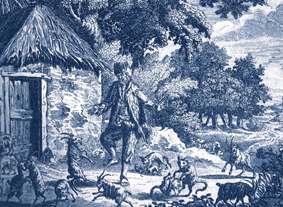
Alexander Selkirk. From the Beken Edition
It needs be remembered, however, that in 1684 Dampier
records that his fellow privateers/pirates landed on Juan
Fernandez Island in order to search for a Moskito Indian
accidently left behind three years earlier. Clennell Wilkinson,
one of Dampier’s biographers, claims that he has almost as
good a claim as Selkirk to be the ‘original’ of Robinson Crusoe,
and noted that the first man ashore was his compatriot who
was named Robin!
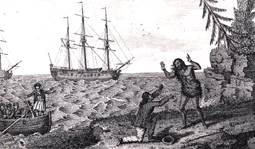
Robin, a Moskito Indian, meets his marooned compatriot.
From the Beken Edition. - top
Meanwhile Dampier continued on in what is described as an
‘unhappy voyage’ in which the discipline steadily deteriorated.
They then engaged a powerful Spanish warship and in repairing
their vessel found that like the Roebuck its hull was rotten.
Many deserted him soon after. Later they captured a small
Spanish barque and then found and unsuccessfully attacked
a well-armed Manila Galleon.
Dampier was blamed for not pressing an advantage he had
earlier obtained and the vessel escaped. (Wilkinson, 1929:
186-200).
Further dissension and desertions ensued. Dampier
successfully sacked a town on the coast of South America
and then captured a Spanish ship to which they transferred
to leave the St George adrift and sinking.
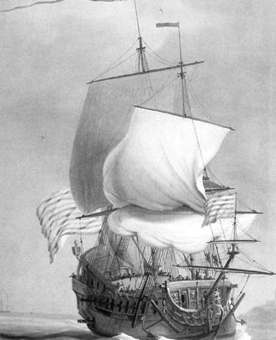
Back to Dampier main page
They sailed to the East Indies where they were arrested,
apparently because Dampier’s commission had expired, and
after an eventual release they made their way home. Dampier
was again penniless, though royalties from his works would
still have been forthcoming.
According to Wilkinson, his friends rallied around him and
Dampier was presented to the Queen to provide an account
of his adventures. He then wrote a Vindication of his voyage
to New Holland in response to a personal attack by the steward
on board the St George, William Funnell, one of Dampier’s
detractors, to whom we owe much of the credit for the
account of this particular voyage (Funnell, 1707).
Though it was not successful in the eyes of the merchants
who backed the voyage, Dampier continued to maintain his
scientific patronage, partly due to the success of his Discourse
on Winds &c. Further his reputation amongst the beleagured
Spanish in the West Indies remained such that he ‘his name
had become a terror in those waters’ (Wilkinson, 1929:204).
Dampier with Woodes Rogers
As a result of this and his reputation as a navigator, Dampier was
offered the post of ‘pilot’ in a voyage by two Bristol-based
privateers the Duke and the Duchess commanded by Captain
Woodes Rogers. When this, his last voyage of circumnavigation
occurred Dampier was 56 years of age and he is recorded in
Woodes Rogers’ list of officers on the Duke as;
‘William Dampier, Pilot for the south Seas,
who had already
been three times there and twice around the world’
(Wilkinson, 1929: 207).
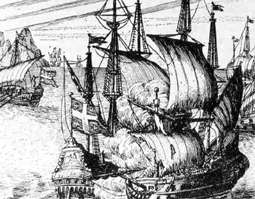
English privateers attacking a Spanish ship
- top
They sailed from Bristol on 2 August 1708 on a voyage notable
for Woodes Rogers’ democratic management, the capture of a
‘Manila Galleon’, and the repatriation of Alexander Selkirk
from
Juan Fernandez Island early the next year.
In a somewhat tantalising note Wilkinson records that Captain
Cooke, one of the second officers who also chronicled the voyage,
stated that when invited return with them, Selkirk
…first enquired whether a certain officer
that he knew was aboard;
and hearing that he was would rather have chosen to remain in
his solitude than come away with him, till informed that he was not
in command’ (Wilkinson, 1929:218)
While Dampier was apparently on friendly terms with Selkirk,
it is possible that the officer referred to is Dampier, and though
to the objective eye it certainly appears so, Wilkinson has offered
the opinion that, ‘in fact, we are left guessing’ (Wilkinson,
1929:218).
Dampier again fails to provide an account of this
incident and of any voyage after the Roebuck adventures, but
both Cooke and Woodes Rogers detail Selkirk’s life in their
subsequent accounts, with Woodes Rogers’ work entitled
Cruising Voyage round the World appearing to great acclaim
a short time after they returned home.
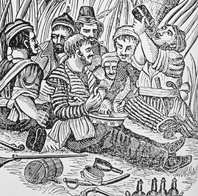
Pirate - Privateers -
top
Later they stormed a Spanish town and also captured one
‘Manila Galleon’ but were badly mauled by another far larger.
They then proceeded home with their prize arriving after further
adventures in October 1711. The three-year voyage proved
lucrative for all involved, including Dampier (Wilkinson, 1929:
Chapter XII).
In November, 1714, at 63 years of age, his health destroyed
after 42 years at sea, and still wrangling after receiving over
£1350 for the voyage (Wilkinson, 1929:237-238) Dampier
made out his will and died in the following March—
Apart from the wreck, the relics, the writings and the portrait,
Dampier left another legacy, his plant specimens. Twenty
four well-pressed species from his Australian plant
collection eventually found their way to the Fielding-Druce
Herbarium at Oxford University, where they appear
beautifully preserved and were viewed by the Museum’s
team en route to Ascension Island.
The whereabouts of the grave of William Dampier
is still unknown.
